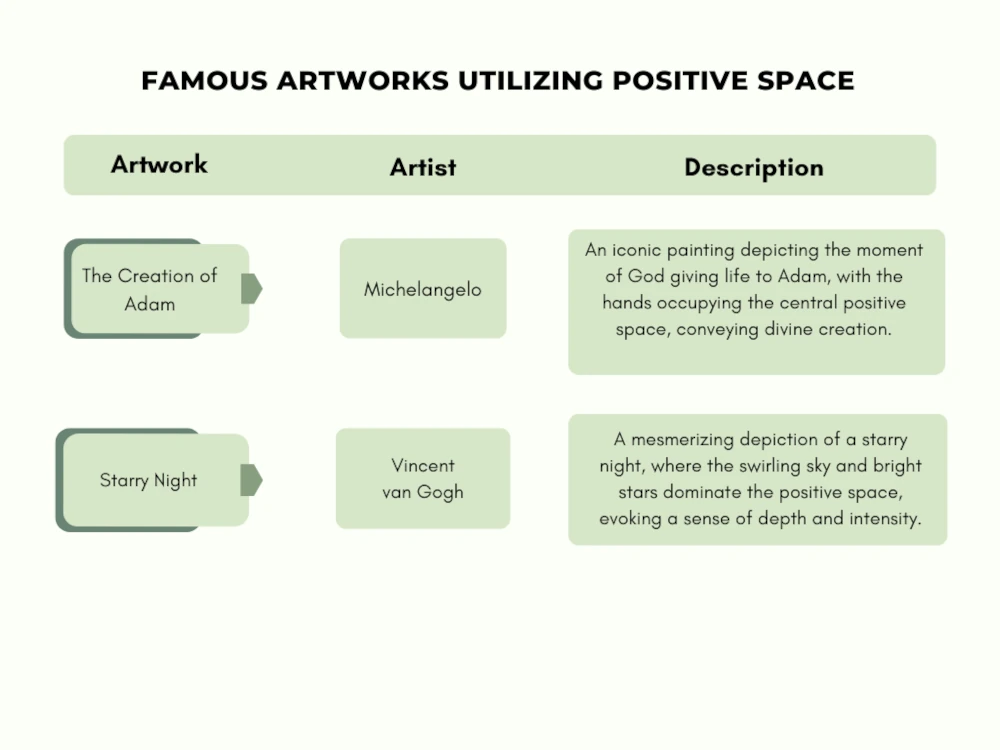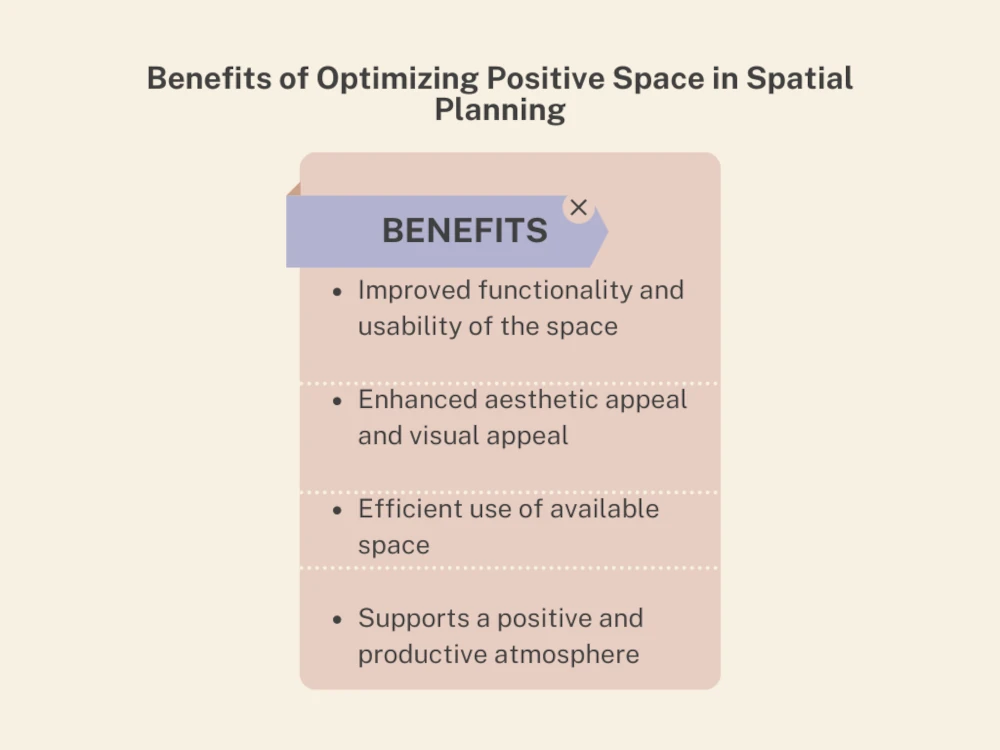Have you ever wondered how artists and filmmakers create visually striking compositions that captivate and engage their audiences? The answer lies in the concept of positive space. But what exactly is positive space, and how does it enhance our visual experiences? In this article, we will explore the definition of this topic and its significance in art, film, and beyond.
Understanding Positive Space in Art
It plays a vital role in art, allowing artists to create visually captivating compositions and convey meaningful messages. It refers to the main subject or objects within a piece of art that occupy the physical space, while negative space surrounds and defines them. By strategically utilizing positive space, artists can guide the viewer’s attention and evoke specific emotions. This section will delve deeper into the significance of positive space in art and explore how artists effectively use it to enhance their visual storytelling and composition.
Famous artworks throughout history serve as prime examples of how positive space can be utilized to great effect. Let’s take a closer look at two renowned paintings:
The Creation of Adam by Michelangelo
In one of the most iconic examples of positive space usage, Michelangelo’s masterpiece, The Creation of Adam, showcases the power of visual storytelling through the manipulation of positive space. The central focus of the painting is the meeting of God and Adam’s hands, which occupy the prominent positive space. The deliberate composition directs the viewer’s attention to this pivotal moment, conveying a profound sense of connection and divine creation.
Starry Night by Vincent van Gogh
Vincent van Gogh’s Starry Night is another exemplary representation of positive space in art. The dominant positive space is occupied by the swirling sky and bright stars, capturing the viewer’s attention and setting the mood for the entire piece. Through the masterful use of positive space, van Gogh creates a sense of depth, movement, and emotional intensity, making Starry Night an enduring masterpiece.
Famous Artworks utilizing Positive Space

The Impact of Positive Space in Film
When it comes to the film industry, positive space plays a crucial role in enhancing the visual narrative and creating effective compositions. Filmmakers intentionally utilize positive space to guide the viewer’s attention, convey emotions, and build suspense.
Enhancing Visual Storytelling
Positive space in film refers to the areas that command the viewer’s focus within the frame. By strategically positioning subjects, objects, or elements of significance in these spaces, filmmakers can effectively communicate the story and evoke specific emotions.
For example, in a thrilling chase scene, the protagonist running through a narrow alley occupies the positive space, emphasizing their urgency and danger. The surrounding environment, being the negative space, enhances the tension and complements the action unfolding on screen.
Creating Engaging Compositions
This is also crucial for creating visually appealing and balanced compositions in film. Careful placement of subjects and objects within the frame can create a sense of harmony and visual interest.
Consider a shot where a character stands at the center of the frame against a vast landscape. The character occupies the positive space, while the expansive scenery becomes the negative space. This composition not only highlights the character’s significance but also immerses the audience in the grandeur of the setting.
Analyzing Iconic Film Scenes
Iconic film scenes often demonstrate the mastery of positive space in visual storytelling and composition. Let’s explore a few notable examples:
![]()
These examples demonstrate how the skilled use of positive space enhances the impact of the storytelling and evokes powerful emotions in the audience.
Creating Space through Spatial Design
The utilization of positive space is paramount in creating visually captivating and functional environments. Effective spatial planning and layout are vital in achieving spaces that are not only aesthetically appealing but also highly practical. By harnessing the power of this, designers can optimize the utilization of the available area and enhance the overall experience within a space. From architectural masterpieces to thoughtfully curated interiors, successful examples abound.
These examples demonstrate the transformative power of positive space in spatial design. From maximizing natural light to facilitating efficient circulation, the thoughtful utilization of positive space significantly enhances both the visual aesthetics and functionality of a space. By embracing this, designers can create environments that inspire, engage, and elevate the overall experience of those who interact with them.
Enhancing Positive Space in Art and Film
In the creative fields of art and film, it plays a crucial role in capturing the viewer’s attention and conveying a visually powerful message. By understanding and utilizing positive space effectively, artists and filmmakers can enhance the impact of their compositions and storytelling. This section explores various techniques and strategies that can be employed to optimize positive space in both art and film, resulting in visually captivating and engaging works.
Creating Effective Layouts
Effective layouts are essential for maximizing the potential of positive space. In art, this involves carefully arranging elements within the frame to create a harmonious balance between positive and negative space. Artists can experiment with different compositions, such as the rule of thirds or golden ratio, to guide the viewer’s eye and create a visually dynamic piece.
In film, effective layouts are achieved through thoughtful cinematography and set design. Filmmakers can utilize various camera angles and perspectives to emphasize positive space, drawing the audience’s attention to key elements. This deliberate arrangement of objects and characters within the frame enhances the overall visual storytelling and reinforces the intended message.

Enhancing Positive Space through Lighting
Lighting is a powerful tool for enhancing positive space in both art and film. By strategically illuminating certain areas, artists and filmmakers can draw the viewer’s focus to specific elements, creating a sense of depth and dimension within the composition.
In art, artists can experiment with different lighting techniques, such as chiaroscuro or high contrast lighting, to accentuate this and create a dramatic effect. By manipulating light and shadow, artists can highlight the areas they want the viewer to focus on, further enhancing the impact of positive space.
In film, lighting plays a crucial role in setting the mood and atmosphere of a scene. Filmmakers can use various lighting setups, such as low-key lighting or high-key lighting, to create visual contrast and emphasize positive space. This not only enhances the aesthetics of the composition but also contributes to the overall narrative and emotional impact of the film.
Utilizing Color and Texture
Color and texture are important elements that can enhance positive space in art and film. By strategically using color and texture, artists and filmmakers can create visual interest and add depth to their compositions.
In art, artists can utilize contrasting colors or bold color choices to draw attention to positive space. By selecting colors that complement or contrast with the surrounding elements, artists can make this visually stand out and create a dynamic focal point.
In film, filmmakers can incorporate textures through production design and cinematography. By using textured surfaces or incorporating visually interesting props, filmmakers can enhance the positive space within a frame. This creates a richer visual experience and helps convey a deeper meaning to the audience.
Conclusion
Positive space is a fundamental element in various fields such as art, film, spatial design, and composition. It plays a crucial role in creating visually compelling and engaging content. By understanding and effectively utilizing this, artists, filmmakers, and designers can elevate their creative work to new heights.
Check out 5 best video production management software
About RFM
RFM is a web-based video, TV, and film production management software that offers various features for professionals in the entertainment industry. It allows users to write professional project briefs and descriptions, talent, and actor showcases, visualize scenes with shot lists, media sharing and manage various aspects of production, including call sheets, shooting schedules, and script breakdowns. RFM is designed to help teams collaborate more effectively during the production process, making it a valuable tool for filmmakers, photographers, and video production companies
Read more of our articles here: Free HVAC Scheduling Software: Streamlining Your Operations